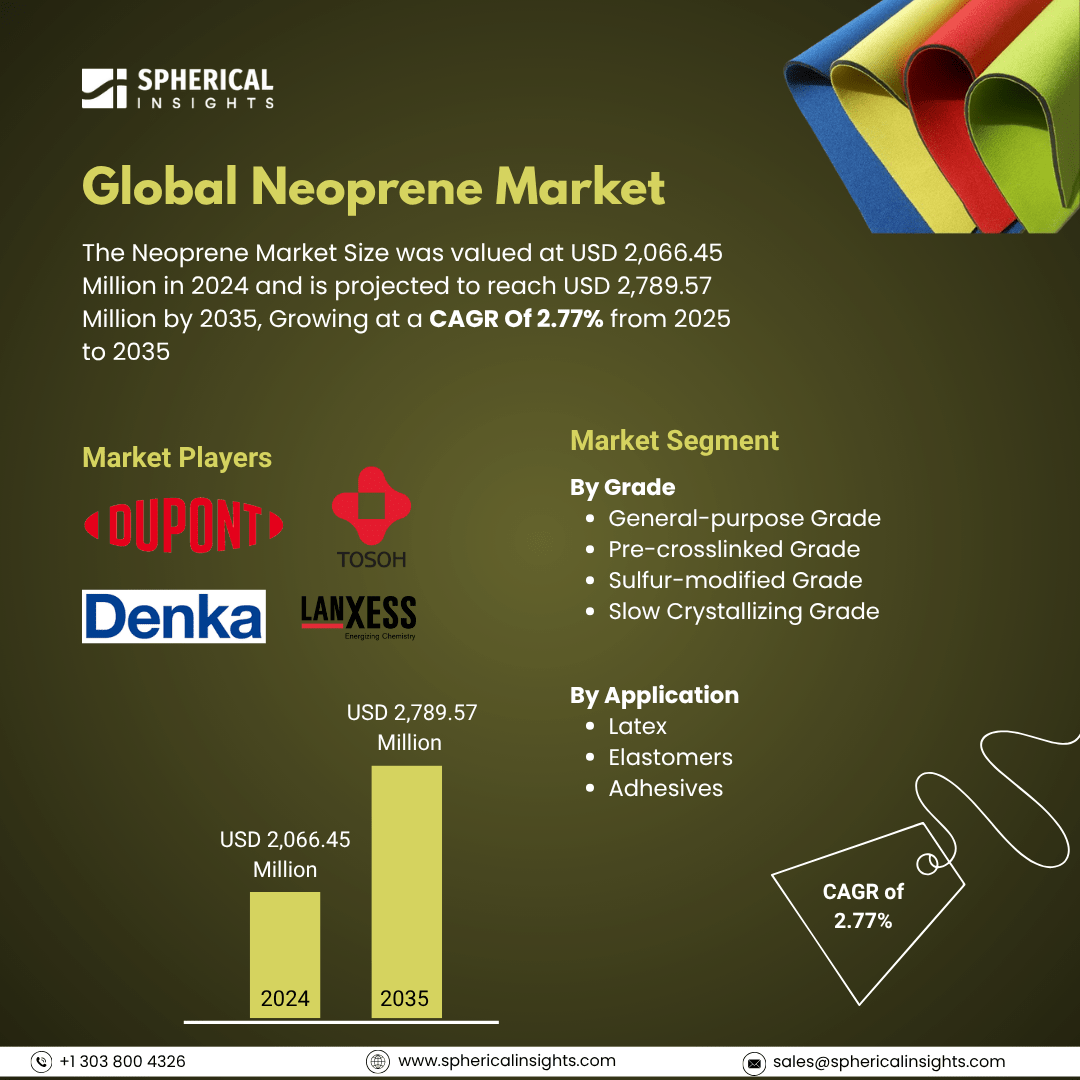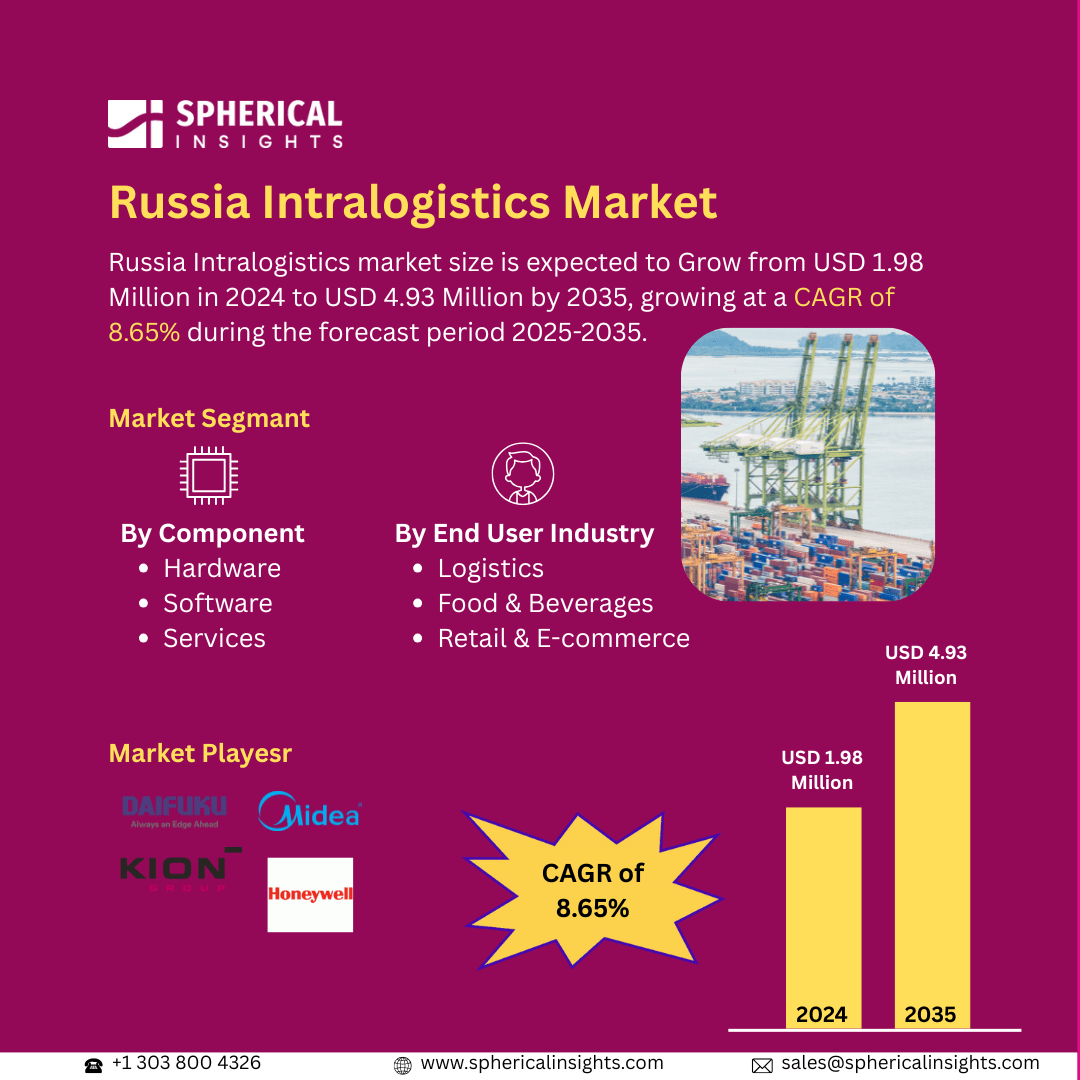Neoprene Market
The Global Neoprene Market Size was valued at USD 2,066.45 Million in 2024 and is projected to reach USD 2,789.57 Million by 2035, Growing at a 2.77% CAGR from 2025 to 2035. Neoprene, a versatile synthetic rubber, plays a crucial role in numerous industries due to its unique blend of durability, flexibility, and resistance to heat, chemicals, and oil. From automotive gaskets and seals to wetsuits and orthopedic supports, neoprene's applications span a wide range of products designed to perform in demanding environments. Its ability to withstand extreme conditions while maintaining elasticity makes it a preferred choice in sectors such as automotive, healthcare, construction, and sports. The global neoprene market is shaped by key manufacturers, with major production hubs in North America, Europe, and Asia-Pacific, particularly in China and India. This material continues to evolve with advancements in technology, enabling manufacturers to create highly specialized products tailored to the specific needs of various industries. As a result, neoprene remains indispensable in high-performance applications worldwide, maintaining its prominence in a dynamic and growing market.
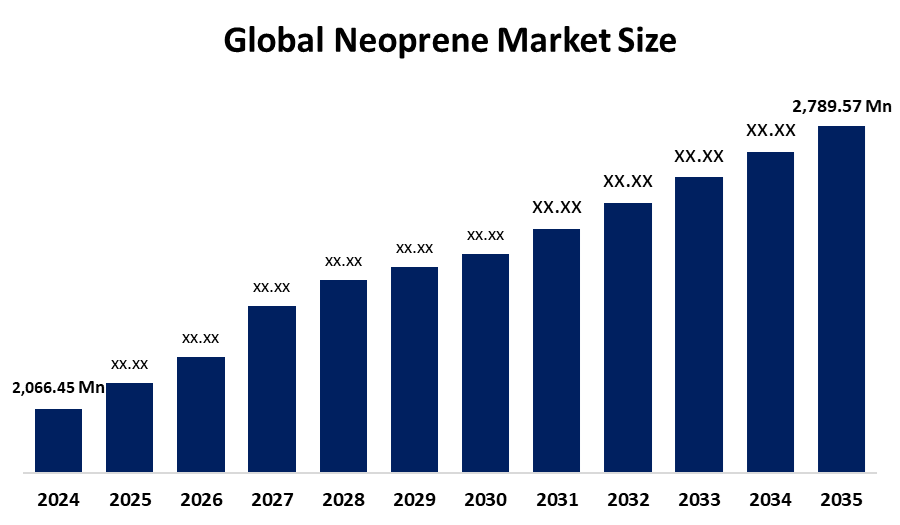
Attractive Opportunities in the Neoprene Market
- Emerging economies in Asia-Pacific and Africa are witnessing rapid industrialization and urbanization, presenting significant opportunities for neoprene manufacturers. These regions are experiencing increased demand in the construction, automotive, and consumer goods sectors, offering a high potential for market penetration and growth.
- Neoprene’s strong resistance to water, temperature extremes, and harsh environmental conditions makes it valuable in the marine and aerospace sectors, where high-performance materials are essential.
- Rising health awareness and increasing participation in sports and fitness activities have led to higher demand for neoprene-based products such as orthopedic supports, braces, gloves, and wetsuits.
Global Neoprene Market Dynamics
DRIVER: Fueled by its indispensable role in a variety of industries
The global neoprene market is witnessing steady growth, fueled by its indispensable role in a variety of industries. Neoprene's unique combination of durability, flexibility, and resistance to heat, oil, and chemicals makes it a preferred material in sectors ranging from automotive to healthcare and sports. In the automotive industry, it’s used for critical components like gaskets and seals, while in healthcare, it plays a vital role in products such as orthopedic supports and medical gloves. The rise in water sports, such as surfing and diving, has also driven demand for neoprene-based wetsuits and protective gear. Technological innovations have further improved the material’s performance, making it more versatile and environmentally sustainable. As industries continue to seek high-performance, long-lasting materials, the demand for neoprene is expected to grow. These driving factors are central to the ongoing expansion of the global neoprene market.
RESTRAINT: Fluctuating cost of raw materials, particularly chloroprene, which significantly affects overall production expenses
A major concern is the fluctuating cost of raw materials, particularly chloroprene, which significantly affects overall production expenses. Moreover, the production of neoprene involves environmentally sensitive chemicals, attracting strict environmental and safety regulations that increase compliance costs and hinder scalability. Rising environmental awareness has also fueled demand for eco-friendly and biodegradable alternatives, gradually reducing neoprene’s appeal in various industries. Competitive pressure from more cost-effective substitutes such as styrene-butadiene rubber (SBR) and thermoplastic elastomers (TPEs) further challenges market growth. Additionally, global supply chain disruptions, geopolitical uncertainties, and trade restrictions can delay product availability and inflate logistics costs.
OPPORTUNITY: Rapid infrastructure growth boosts demand for neoprene
The global neoprene market is witnessing promising opportunities driven by its diverse applications and material benefits. Rapid infrastructure growth boosts demand for neoprene in sealing and insulation. In the sports and medical sectors, rising health awareness fuels the need for neoprene-based gear and supports. Technological innovations are enabling eco-friendly neoprene production, aligning with sustainability trends. Additionally, its resistance to water and harsh conditions makes it valuable in marine and aerospace industries. Emerging economies in Asia-Pacific and Africa offer untapped potential due to increasing industrialization and consumer demand, positioning these regions as key targets for future market expansion and investment.
CHALLENGES: Environmental and health concerns related to its production process have triggered increasingly strict regulations
A major hurdle is the dependence on chloroprene, a petroleum-based raw material subject to price volatility and supply chain disruptions. Environmental and health concerns related to its production process have triggered increasingly strict regulations, particularly in regions with strong environmental policies. These regulatory pressures demand costly modifications and greener manufacturing approaches. Furthermore, the rise of alternative materials like thermoplastic elastomers (TPEs) and natural rubbers, which offer cost-effective and eco-friendlier options, intensifies competitive pressure. Limited recyclability and non-biodegradability of neoprene also pose sustainability issues, especially as industries and consumers shift toward greener materials.
Global Neoprene Market Ecosystem Analysis
The global neoprene market ecosystem includes raw material suppliers, manufacturers like Denka, Lanxess, and Shanxi Synthetic Rubber, and sellers such as DuPont and 3M. These players produce and distribute neoprene for use in automotive, construction, sports, and medical industries. Distributors and wholesalers ensure market reach, while end-users rely on neoprene’s durability and flexibility. Regulatory bodies influence the ecosystem through environmental and safety standards, pushing for sustainable manufacturing. Innovation and green chemistry are increasingly shaping the ecosystem’s future direction.
Based on the grade, the general-purpose grade segment held the largest revenue share and is expected to grow at a remarkable CAGR during the forecast period
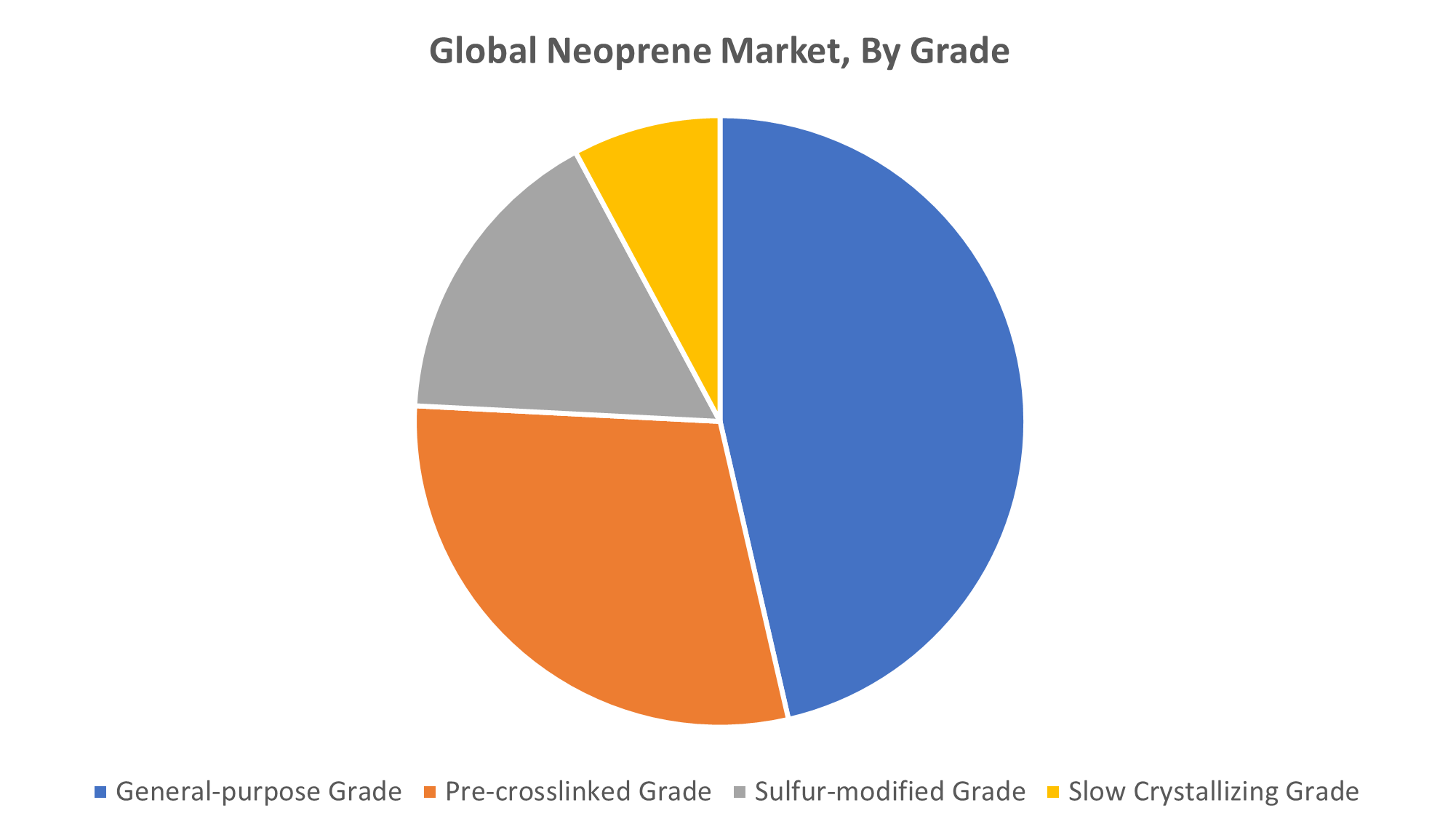
The general-purpose grade segment holds the largest share in the global neoprene market due to its broad utility, reliability, and cost-effectiveness. This grade of neoprene is characterized by its balanced physical and chemical properties, offering a strong combination of elasticity, moderate oil and chemical resistance, good thermal stability, and excellent weather and ozone resistance. Because of these qualities, general-purpose neoprene is widely used across a variety of end-use industries. In the automotive sector, it is used for making belts, hoses, gaskets, and under-the-hood components due to its ability to withstand heat and oil. In the construction industry, it finds applications in insulation, expansion joints, vibration mounts, and waterproof membranes. In consumer goods, it's used for making laptop sleeves, protective gloves, and orthopedic supports. Even in electronics, it's applied in cable insulation and protective casings.
Based on the application, the elastomers dominated the neoprene market with a revenue share of substantial CAGR during the forecast period
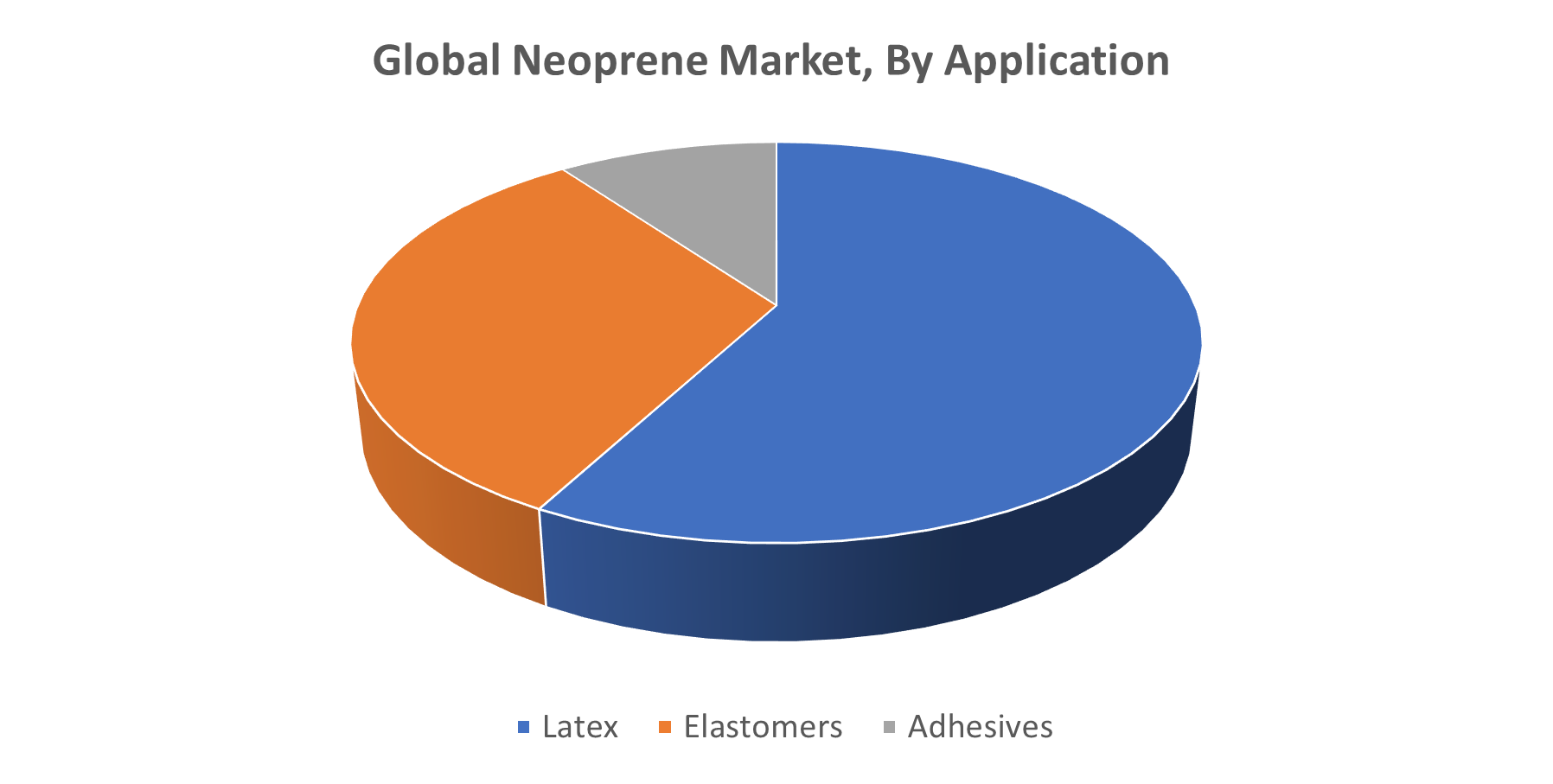
Neoprene elastomers are highly valued for their excellent mechanical properties, including flexibility, resilience, abrasion resistance, and resistance to oils, chemicals, and extreme weather conditions. These attributes make neoprene elastomers ideal for a wide range of industrial applications. They are extensively used in the automotive industry for manufacturing belts, hoses, gaskets, and mounts due to their durability and heat resistance. In the construction sector, they are applied in sealing, vibration dampening, and waterproofing systems. Additionally, their application in electrical insulation, protective clothing, and adhesives further supports their widespread demand. The versatility and performance efficiency of neoprene elastomers have positioned them as a preferred material across various sectors, ensuring their continued dominance in the application landscape of the neoprene market.
Based on the end use, the building and construction segment is expected to hold the largest share during the forecast period
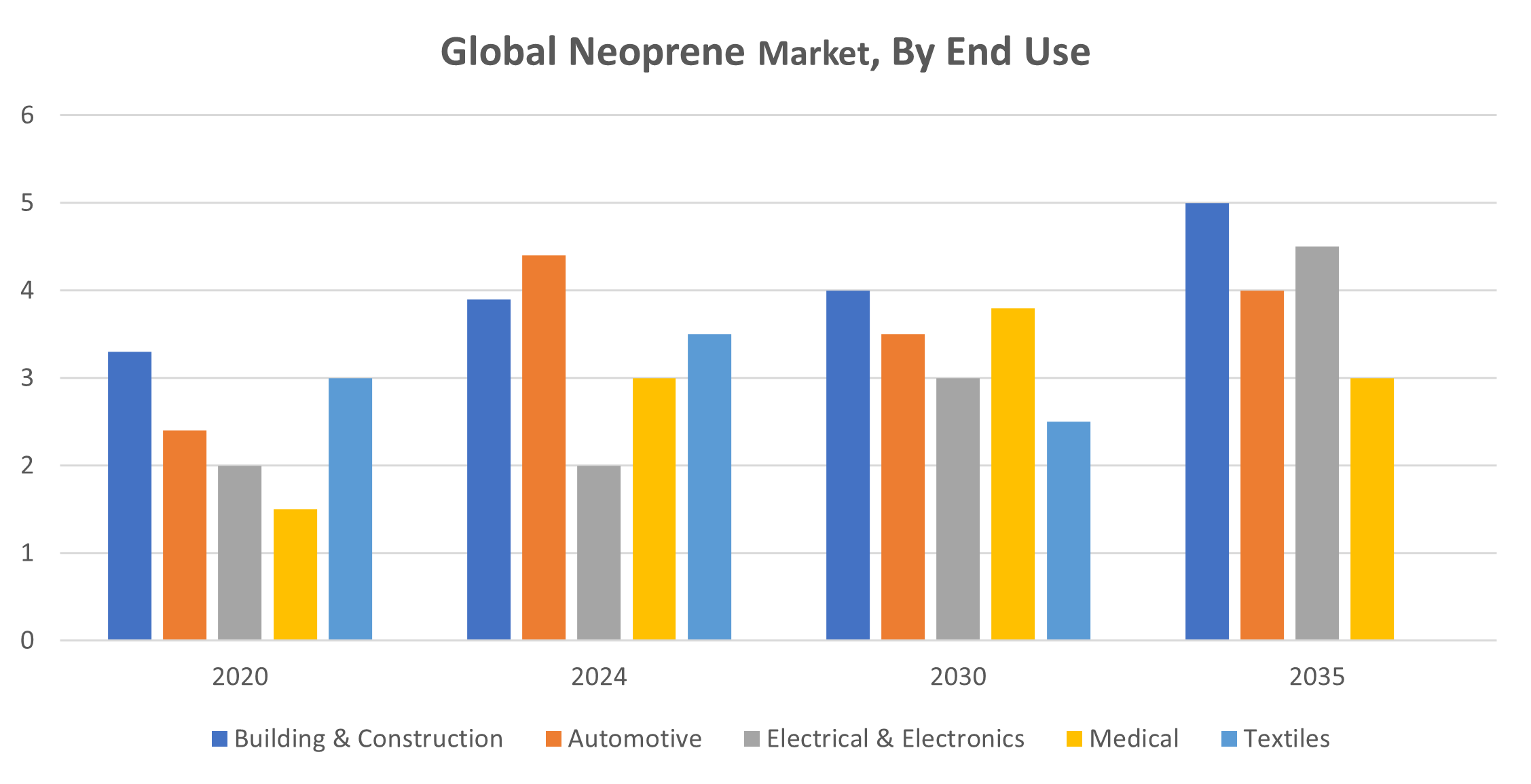
Driven by increasing infrastructure development and demand for reliable materials, the building and construction segment accounted for the highest revenue share in the global neoprene market and is expected to grow at a remarkable CAGR during the forecast period. Neoprene is widely used in this sector due to its excellent resistance to weather, water, heat, and chemicals. It is commonly applied in expansion joints, window seals, waterproofing membranes, and insulation systems. Its durability and flexibility make it a preferred choice for both residential and commercial construction. With rapid urbanization and construction activities, especially in emerging economies, this segment is set to expand significantly.
Asia Pacific is anticipated to hold the largest share of the neoprene market during the forecast period
Asia Pacific is expected to dominate the global neoprene market during the forecast period, fueled by robust growth in industrial, automotive, and construction sectors. The region, led by economies such as China, India, and South Korea, is witnessing a surge in infrastructure development and manufacturing activities, which significantly drive the demand for neoprene-based products. Rapid urbanization, rising investments in transportation networks, and the increasing need for durable, weather-resistant materials are further propelling market growth. Additionally, the availability of low-cost labor and raw materials, along with the presence of major neoprene producers, positions Asia Pacific as a key hub for both production and consumption in the global neoprene market.
North America is expected to grow at a significant CAGR in the neoprene market during the forecast period
North America is projected to grow at a significant CAGR in the neoprene market during the forecast period, driven by rising demand across industries such as automotive, construction, sports, and healthcare. The region benefits from strong industrial infrastructure, advanced manufacturing capabilities, and a growing focus on high-performance and durable materials. In the United States and Canada, neoprene is widely used for automotive parts, protective gear, medical braces, and insulation materials. Additionally, increasing investments in infrastructure projects and the adoption of advanced materials in consumer goods are fueling market expansion. The presence of leading manufacturers and innovation in product development further supports the region's growth.
Recent Developments of the Neoprene Market
- In January 2025, Lomo Watersport unveiled Lomotec Neo, a flexible, eco-friendly neoprene alternative for wetsuits, designed to be more affordable than similar "green" products.
Key Market Players
KEY PLAYERS IN THE NEOPRENE MARKET INCLUDE
- DuPont de Nemours, Inc.
- Denka Company Limited
- Tosoh Corporation
- LANXESS AG
- LG Chem Ltd.
- Shanxi Synthetic Rubber Group Co., Ltd.
- Chongqing Changshou Chemical Co., Ltd.
- Zenith Industrial Rubber Products Pvt. Ltd.
- Covestro AG
- The 3M Company
- Others
Market Segment
This study forecasts revenue at global, regional, and country levels from 2020 to 2035. Spherical Insights has segmented the neoprene market based on the below-mentioned segments:
Global Neoprene Market, By Grade
- General-purpose Grade
- Pre-crosslinked Grade
- Sulfur-modified Grade
- Slow Crystallizing Grade
Global Neoprene Market, By Application
- Latex
- Elastomers
- Adhesives
Global Neoprene Market, By End Use
- Building & Construction
- Automotive
- Electrical & Electronics
- Medical
- Textiles
Global Neoprene Market, By Regional Analysis
- North America
- Europe
- Germany
- UK
- France
- Italy
- Spain
- Russia
- Rest of Europe
- Asia Pacific
- China
- Japan
- India
- South Korea
- Australia
- Rest of Asia Pacific
- South America
- Brazil
- Argentina
- Rest of South America
- Middle East & Africa
- UAE
- Saudi Arabia
- Qatar
- South Africa
- Rest of the Middle East & Africa
